|
|
|
|
Coordinate geometry
(or Analytic geometry) in three-dimensional space
|
|
|
|
Point,
line and plane – orthogonal
projections, distances, perpendicularity of line and plane
|
|
Through a given point pass a line perpendicular to a given plane
|
|
In this case, the normal vector
N
of a plane is
collinear or coincide
with the direction vector |
| s =
ai + bj + ck
of a line, |
| that is,
s =
N =
Ai + Bj + Ck. |
|
The
given point A(x0,
y0,
z0)
when plugged into rewritten
equation of the line gives
|
 |
|
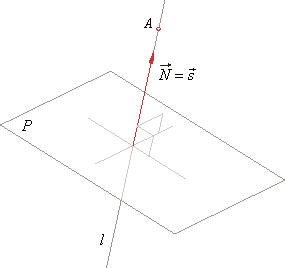 |
|
|
Example:
Determine the equation of a line which passes through
the point A(-3, 5,
-1) perpendicular to the
plane
2x -
y + 4z - 3 =
0.
|
|
Solution: By
plugging the point A(-3, 5,
-1)
and the components of the normal vector
|
|
N =
s
= 2i -
j + 4k
of the given plane into
the above equation of the line obtained is
|
 |
|
the equation of the line perpendicular to the given plane that
passes through the given point.
|
|
|
Given a line and a point, through
the point lay a plane perpendicular to the line
|
|
The direction vector
s
of a line is now collinear or coincide
with
the normal vector N of a plane
so that |
| N =
s =
ai + bj + ck. |
|
Coordinates of the given point
A(x0,
y0,
z0)
is plugged into the
rewritten equation
of a plane
|
| P
::
a · x0 + b · y0 + c · z0 + D = 0 |
| to determine the parameter
D. |
|
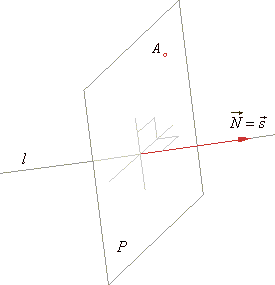 |
|
| Example:
Given is a line |
 |
and a point
A(-2, 1,
4), through the point lay a plane
|
|
| perpendicular to the line. |
|
Solution: In the above equation of the line, the zero in the denominator denotes that the direction
vector's component
c =
0, it does not mean division by zero. Consider this as symbolic
notation.
|
|
It means that the given line is parallel with the
xy coordinate plane on the distance
z = 3 that is, the coordinate
z
of each point of the line has the value 3.
|
| Since
N =
s
then, N =
-i
+ 3j
or
N =
Ai + Bj + Ck.
|
|
The coordinate of the point must satisfy the equation of the plane
Ax + By + Cz +
D = 0
that is,
|
| A(-2, 1,
4) => Ax + By + Cz + D = 0
gives -1 · (-2)
+ 3 · 1
+ 0 · 4 +
D = 0, D =
-5.
|
|
Therefore,
P
:: -2x +
3y -
5 = 0 is the plane through the given point perpendicular to the given line.
|
|
|
|
Projection of a point onto a plane
|
|
A given point A(x0,
y0,
z0)
and its projection
A′ determine a line of which the direction vector
s
coincides
|
|
with the normal
vector
N
of the projection plane
P.
|
|
As the point
A′ lies at the same time on the line AA′ and the plane
P, the coordinates of the radius (position)
vector of a variable point of the line written in the
parametric form |
| x
= x0 + a · t,
y
= y0 + b
· t and
z = z0
+ c
· t, |
|
These variable coordinates of a point of the line
plugged
into the equation of the plane will determine the value of the parameter t
such that this point will be, at the same
time on the line and the plane. |
|
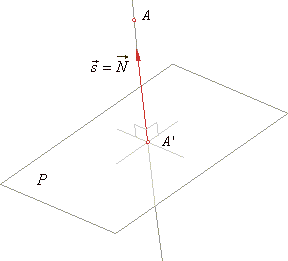 |
|
|
|
Projection of a point onto a line
|
|
If we lay through a given point A a plane
P perpendicular to a given line then will, the intersection of the
|
|
line and the plane, at the same time be the projection
A′ of the point onto the
line. |
|
Then, the normal vector of the plane and the direction vector of the given
line coincide, i.e.,
|
|
N =
s
|
|
and since the coordinates of the given point must satisfy the equation of
the plane, that way the plane is determined.
|
|
As the intersection
A′
is the common point of the line and the plane
then the parametric coordinates of a radius vector of the line plugged
into the equation of the plane will determine the value of a parameter
t
such
that this condition to be satisfied. |
|
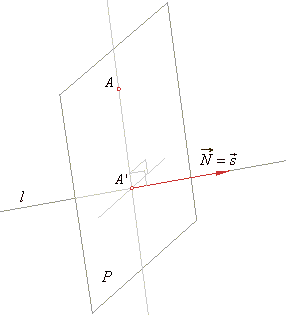 |
|
|
|
Example:
Find the projection of the point A(4,
-2,
1) onto the line |
 |
|
|
Solution: The normal vector of a plane, perpendicular to the given line, coincides to the direction vector of
the line, that is N =
s
= -3i
+
5 j + 3k.
|
| As the plane must pass through the point
A, then
|
| A(4,
-2,
1) =>
-3x +
5y + 3z + D = 0 =>
-3 · 4 + 5 · (-2)
+ 3 · 1 + D = 0,
D = 19
|
|
Since the intersection is the common point of the given line and the plane then the coordinates of the
radius vector of the intersection must satisfy the equation of the plane that is,
|
 |
|
and plugged into the plane
|
| -3 · (-3t
-
1) + 5
· (5t
+ 3)
+ 3
· (3t
+ 2) + 19 = 0,
t = -1
|
|
Thus, the coordinates of the intersection or the projection
A′
are,
|
| x = -3 · (-1)
-
1 = 2, y =
5
· (-1)
+ 3 =
-2
and z = 3
· (-1)
+ 2
= -1,
A′(2, -2,
-1).
|
|
|
Through a given point lay a line perpendicular to a given line
|
|
A line which will pass through a given point perpendicular to a given line will lie in a plane that is
perpendicular to the given line and which passes through the given point.
|
|
The equation of that line is then
determined by two points, the given point and by its projection onto the given line or the intersection with the
plane.
|
|
|
Projection of a line onto a plane
|
|
Orthogonal projection of a line onto a plane is a line or a point. If a given line is perpendicular to a plane, its
projection is a point, that is the intersection point with the plane, and its direction vector
s
is coincident with the normal vector N
of the plane.
|
|
If a line is parallel with a plane then it is also parallel with its projection onto the plane and orthogonal to the normal vector of the plane that is |
| s
^ N
=>
s
· N = 0. |
|
Projection of a
line which is not parallel nor perpendicular to a plane, passes through their intersection
B and through the
projection A´
of any point
A
of the line onto the plane,
as shows the right figure. |
|
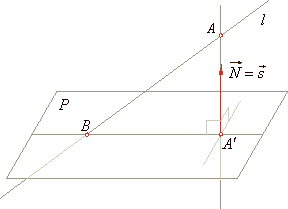 |
|
|
|
Example:
Projection of the line |
 |
onto the plane
13x -
9y + 16z -
69 = 0. |
|
|
Solution: Intersection of the given plane and
the orthogonal plane through the given line, that is, the plane
through three points, intersection point
B, the point
A
of the given line and its projection A´
onto the plane, is at the same time projection of the given line onto the given
plane, as shows the right figure.
|
|
The direction vector
N1, of the plane determined by three points
A,
B and
A´, is the result of the vector product of the normal vector of the given plane and the direction vector
s of the given line, that is
|
 |
|
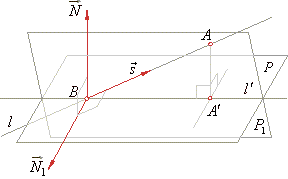 |
|
| By
plugging the point A(15,
-12,
17) into the equation of the plane, |
| A(15,
-12,
17) => 141x
+
97y
-
60z + D = 0,
141 · 15 +
97 · (-12) -
60 · 17 + D =
0, D = 69
|
| obtained
is the equation of the plane P1
:: 141x + 97y -
60z + 69 = 0. |
| The line of the intersection
l´
of the given plane |
| P
::
13x -
9y + 16z -
69 = 0 and the plane P1
:: 141x + 97y -
60z + 69 = 0 |
| is at the same time the projection of
the given line onto the given plane (see the previous page). |
|
|
|
|
|
|
|
|
|
|
|
|
|
|
|
|
|
|
|
|
|
|
|
|
|
|
|
|
Contents C
|
|
|
|
|

|
|
|
|
|
|
Copyright
© 2004 - 2020, Nabla Ltd. All rights reserved.
|
|
|